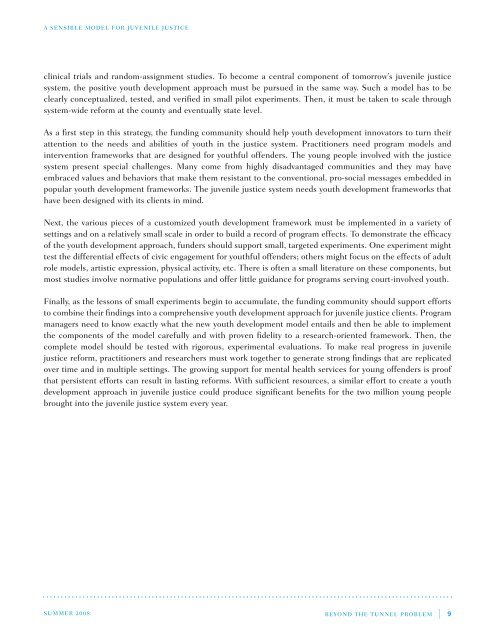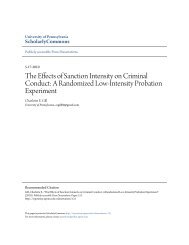A Sensible Model for Juvenile Justice - JDAI Helpdesk
A Sensible Model for Juvenile Justice - JDAI Helpdesk
A Sensible Model for Juvenile Justice - JDAI Helpdesk
You also want an ePaper? Increase the reach of your titles
YUMPU automatically turns print PDFs into web optimized ePapers that Google loves.
A SENSIBLE MODEL FOR JUVENILE JUSTICE<br />
clinical trials and random-assignment studies. To become a central component of tomorrow’s juvenile justice<br />
system, the positive youth development approach must be pursued in the same way. Such a model has to be<br />
clearly conceptualized, tested, and verified in small pilot experiments. Then, it must be taken to scale through<br />
system-wide re<strong>for</strong>m at the county and eventually state level.<br />
As a first step in this strategy, the funding community should help youth development innovators to turn their<br />
attention to the needs and abilities of youth in the justice system. Practitioners need program models and<br />
intervention frameworks that are designed <strong>for</strong> youthful offenders. The young people involved with the justice<br />
system present special challenges. Many come from highly disadvantaged communities and they may have<br />
embraced values and behaviors that make them resistant to the conventional, pro-social messages embedded in<br />
popular youth development frameworks. The juvenile justice system needs youth development frameworks that<br />
have been designed with its clients in mind.<br />
Next, the various pieces of a customized youth development framework must be implemented in a variety of<br />
settings and on a relatively small scale in order to build a record of program effects. To demonstrate the efficacy<br />
of the youth development approach, funders should support small, targeted experiments. One experiment might<br />
test the differential effects of civic engagement <strong>for</strong> youthful offenders; others might focus on the effects of adult<br />
role models, artistic expression, physical activity, etc. There is often a small literature on these components, but<br />
most studies involve normative populations and offer little guidance <strong>for</strong> programs serving court-involved youth.<br />
Finally, as the lessons of small experiments begin to accumulate, the funding community should support ef<strong>for</strong>ts<br />
to combine their findings into a comprehensive youth development approach <strong>for</strong> juvenile justice clients. Program<br />
managers need to know exactly what the new youth development model entails and then be able to implement<br />
the components of the model carefully and with proven fidelity to a research-oriented framework. Then, the<br />
complete model should be tested with rigorous, experimental evaluations. To make real progress in juvenile<br />
justice re<strong>for</strong>m, practitioners and researchers must work together to generate strong findings that are replicated<br />
over time and in multiple settings. The growing support <strong>for</strong> mental health services <strong>for</strong> young offenders is proof<br />
that persistent ef<strong>for</strong>ts can result in lasting re<strong>for</strong>ms. With sufficient resources, a similar ef<strong>for</strong>t to create a youth<br />
development approach in juvenile justice could produce significant benefits <strong>for</strong> the two million young people<br />
brought into the juvenile justice system every year.<br />
SUMMER 2008 BEYOND THE TUNNEL PROBLEM | 9

















